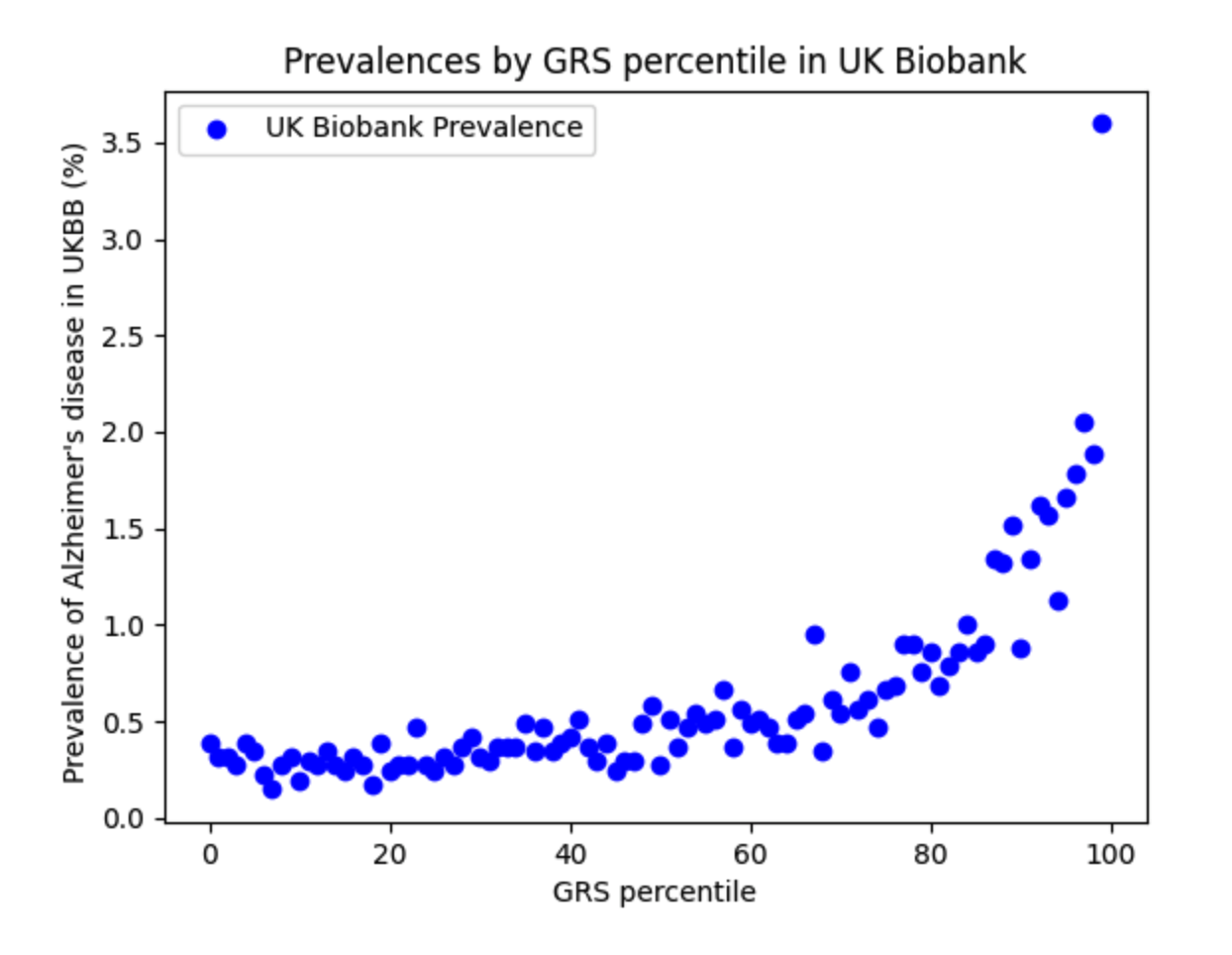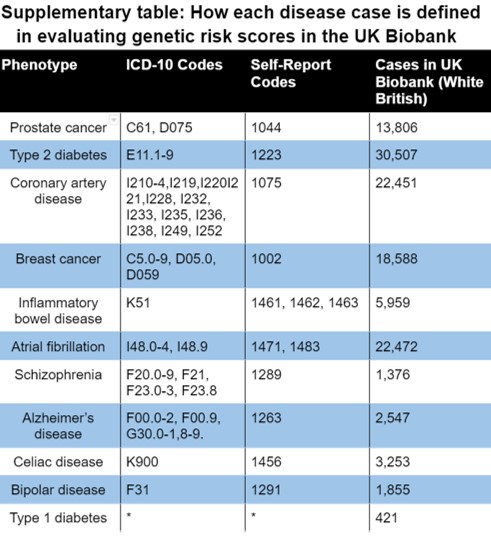Orchid's team of genetic experts has developed a genetic risk score (GRS) for Alzheimer's disease.
Written by Orchid Team
Orchid has developed advanced genetic risk scores (GRS) for a variety of diseases. Here we present our data on our GRS of Alzheimer's disease.
Alzheimer’s Disease
Alzheimer’s disease (AD) is a chronic, irreversible, neurodegenerative disease with no known cure. It causes brain cells to die and produces harmful deposits, called amyloid plaques, which appear around the neurons of the brain [1]. There is some debate around the precise mechanism for developing Alzheimer’s disease. The disease is substantially influenced by genetic factors, with its heritability being estimated between 60 and 80%, based on an analysis conducted using data on almost 12,000 twin pairs drawn from the Swedish twin registry [2], [3].
Genetic risk score (GRS)
A genetic risk score quantifies the degree to which an individual’s genetics increases their likelihood of developing a specific disease. The GRS for AD includes 1,111,805 variants and was developed based on the variants identified in a study that analyzed genomes of about 455,258 individuals of European ancestry affected by AD [4]. The study included 17008 cases (individuals with AD) and 37154 healthy controls.
Our AD GRS has some special characteristics relative to our usual GRS. For AD, one specific loci, APOE, confers a disproportionate share of genetic risk. That is, AD follows an oligogenic model, not a classic polygenic model. For that reason, the resulting GRS is not normally distributed.

Clinical Impact and Prevalence
Most diagnoses of Alzheimer’s disease (AD) are made in the developed world [2]. In 2020 about 5.8 million Americans (1.7%) had AD, and most were diagnosed after the age of 60 [5] with the average age of diagnosis being 75 [6]. Aside from the neurological symptoms such as cerebral atrophy and plaque deposits, AD produces a range of cognitive symptoms such as impaired memory and thinking, sleeplessness, social withdrawal, and distrust in others [7]. The disease is fatal, and although most sufferers do not live beyond 10 years after being diagnosed[8], the FDA has approved one medication, aducanumab, for treatment [1].
Performant Alzheimer's disease risk stratification
Validated using a large cohort of real world individuals with known Alzheimer's disease status
Because the discovery GWAS data included samples from the UK Biobank, to validate we tested the performance of the GRS on the set of samples not included in that study: participants who did not have a known parental status of Alzheimer's disease. Individuals in the 99th percentile of genetic risk have a 9.90% percent prevalence of Alzheimer's disease (AD), compared to the average of 0.93% percent. This is lower than the lifetime prevalence of AD reported for US individuals, as a result of the median age of the UK Biobank (58), which means that many individuals who will eventually develop AD have not yet done so. This biases the prevalence of AD within the UK Biobank downwards substantially relative to the average lifetime prevalence of 1.7% in the US.

Validation in UK Biobank. In the UK Biobank, cases were identified using self-reported Alzheimer's disease (UK Biobank field 20002) relevant ICD-9/ICD-10 diagnosis. Because the discovery GWAS data included samples from the UK Biobank, to validate we tested the performance of the GRS on the set of samples not included in that study: participants who did not have a known parental status of Alzheimer's disease. See our supplementary table for full details. In the validation, the prevalence of Alzheimer's disease increased with GRS. We restricted our analysis to self-reported British white individuals whose genetic ancestry matched their self-identification. With our phenotype definition there were 452 cases of Alzheimer's disease and 45,909 controls.

Identification of individuals at 10-11 times the baseline risk of Alzheimer's disease
individuals in the 99th percentile of genetic risk develop Alzheimer's disease at 10.6 times the baseline rate. The odds ratio for individuals in the 99th percentile was 11.7. Baseline rate is the prevalence of the disease in the entire reference population.
Comparison to Published Benchmarks
Orchid’s model achieves an AUC of 0.839 compared to the benchmark of 0.782.

We compared our model’s performance as validated on the UK Biobank to the best model in Gatz et al[4], using age and principal components as covariates to match their methodology. Without covariates, our model achieves an AUC of 0.724. Because the benchmarks use different datasets, the results are not directly comparable.
1 We have omitted the top 0.5% category because of the small sample size of cases in that bucket.
2 Escott-Price et a.l [4]
3 Because the PRS distribution for this phenotype is not normally distributed, OR per std is not an appropriate metric, and so we have not reported it.
Citations
1. Alzheimer’s Disease Fact Sheet. [cited 4 Jan 2022]. Available: http://www.nia.nih.gov/health/alzheimers-disease-fact-sheet
2. Van Cauwenberghe C, Van Broeckhoven C, Sleegers K. The genetic landscape of Alzheimer disease: clinical implications and perspectives. Genet Med. 2016;18: 421.
3. Gatz M, Reynolds CA, Fratiglioni L, Johansson B, Mortimer JA, Berg S, et al. Role of genes and environments for explaining Alzheimer disease. Arch Gen Psychiatry. 2006;63. doi:10.1001/archpsyc.63.2.168
4. Jansen IE, Savage JE, Watanabe K, et al. Genome-wide meta-analysis identifies new loci and functional pathways influencing Alzheimer's disease risk [published correction appears in Nat Genet. 2020 Mar;52(3):354]. Nat Genet. 2019;51(3):404-413.
5. What is Alzheimer’s Disease? 7 Apr 2021 [cited 4 Jan 2022]. Available: https://www.cdc.gov/aging/aginginfo/alzheimers.htm
6. Barnes J, Dickerson B, Frost C, Jiskoot LC, Wolk D, van der Flier WM. Alzheimer’s disease first symptoms are age dependent: evidence from the NACC dataset. Alzheimers Dement. 2015;11: 1349.
7. Alzheimer’s disease. [cited 4 Jan 2022]. Available: https://www.mayoclinic.org/diseases-conditions/alzheimers-disease/symptoms-causes/syc-20350447
8. Todd S, Barr S, Roberts M, Passmore AP. Survival in dementia and predictors of mortality: a review. Int J Geriatr Psychiatry. 2013;28. doi:10.1002/gps.3946
Appendix: Disease case identification and number of cases in UK Biobank

*Type 1 diabetes was defined as a combination the following inclusion and exclusion criteria:
- Self-diagnosed diabetes (any type)
- No self-diagnosed Type 2 diabetes
- Age of diabetes onset between 0 and 20 years
- Started insulin within one year of diagnosis of diabetes







